Here you can see high-rises with Oriental decor and merchant houses with carved platbands and wooden pillars, a Buddhist datsan near a Christian church, magnificent Stalinist architecture mixed in with cookie-cutter khrushchevkas.
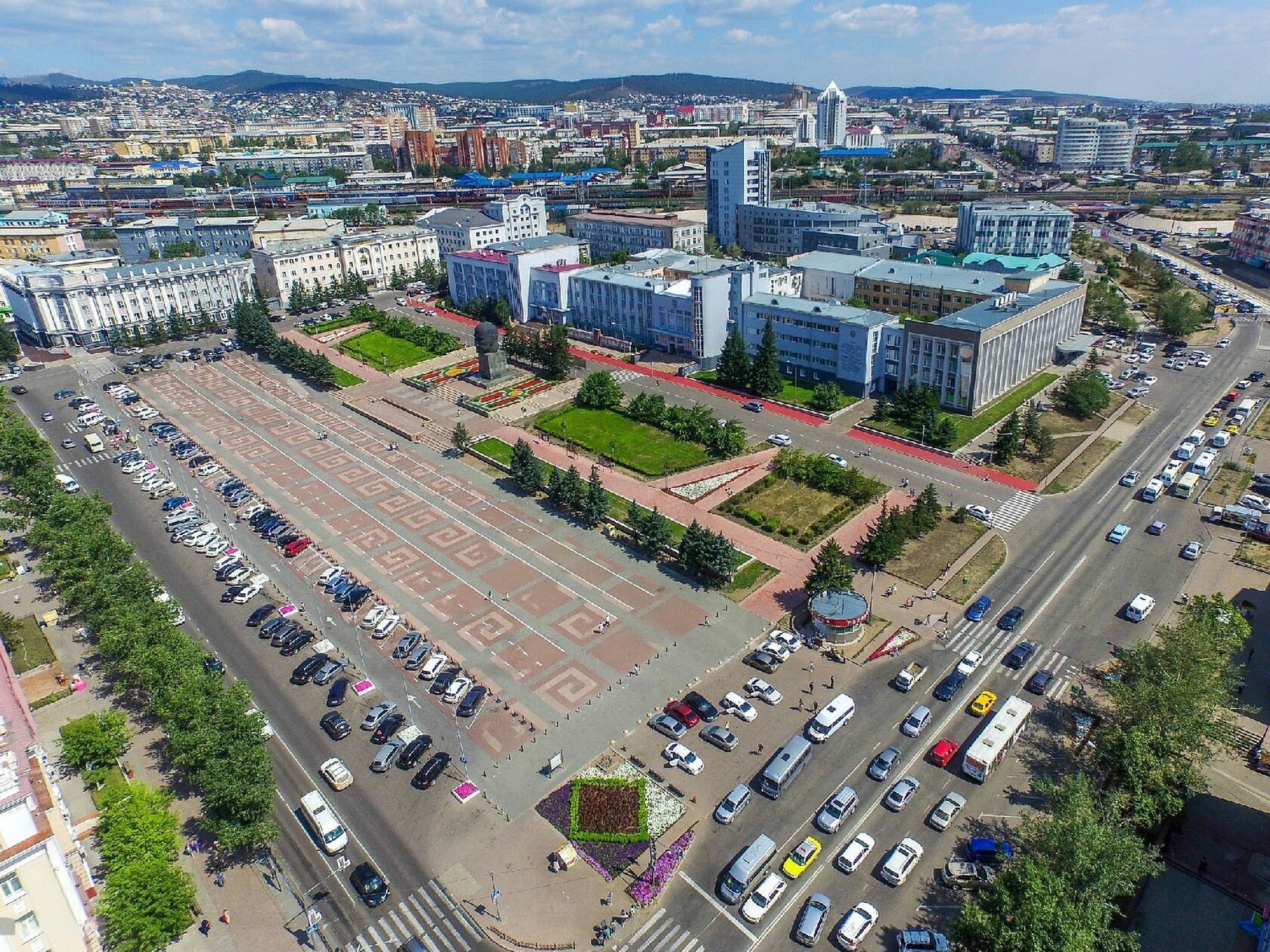
1 Soviets Square
The famous Lenin's head on the main square is a magnet for all tourists coming to Buryatia's capital. Two parts of the huge monument were cast in Mytishchi in 1970 and delivered here by rail. Since then, Ulan-Ude has been the home of the largest head of Lenin in the world. The sculpture is often depicted on postcards and magnets as the symbol of the city, people add caps, glasses or ushanka hats to its photos, and during the pandemic some volunteers suggested making a gigantic face mask for the head. Administrative buildings surround the monument.
Sovietov Square is a venue for large concerts, exhibitions and other urban events, and in winter it's the place for the main ice village. In summer, the square is a cozy urban space, where you can ride on swings, snack on fast-food, hide in the shade or relax in gazebos.
The famous Lenin's head on the main square is a magnet for all tourists coming to Buryatia's capital. Two parts of the huge monument were cast in Mytishchi in 1970 and delivered here by rail. Since then, Ulan-Ude has been the home of the largest head of Lenin in the world. The sculpture is often depicted on postcards and magnets as the symbol of the city, people add caps, glasses or ushanka hats to its photos, and during the pandemic some volunteers suggested making a gigantic face mask for the head. Administrative buildings surround the monument.
Sovietov Square is a venue for large concerts, exhibitions and other urban events, and in winter it's the place for the main ice village. In summer, the square is a cozy urban space, where you can ride on swings, snack on fast-food, hide in the shade or relax in gazebos.
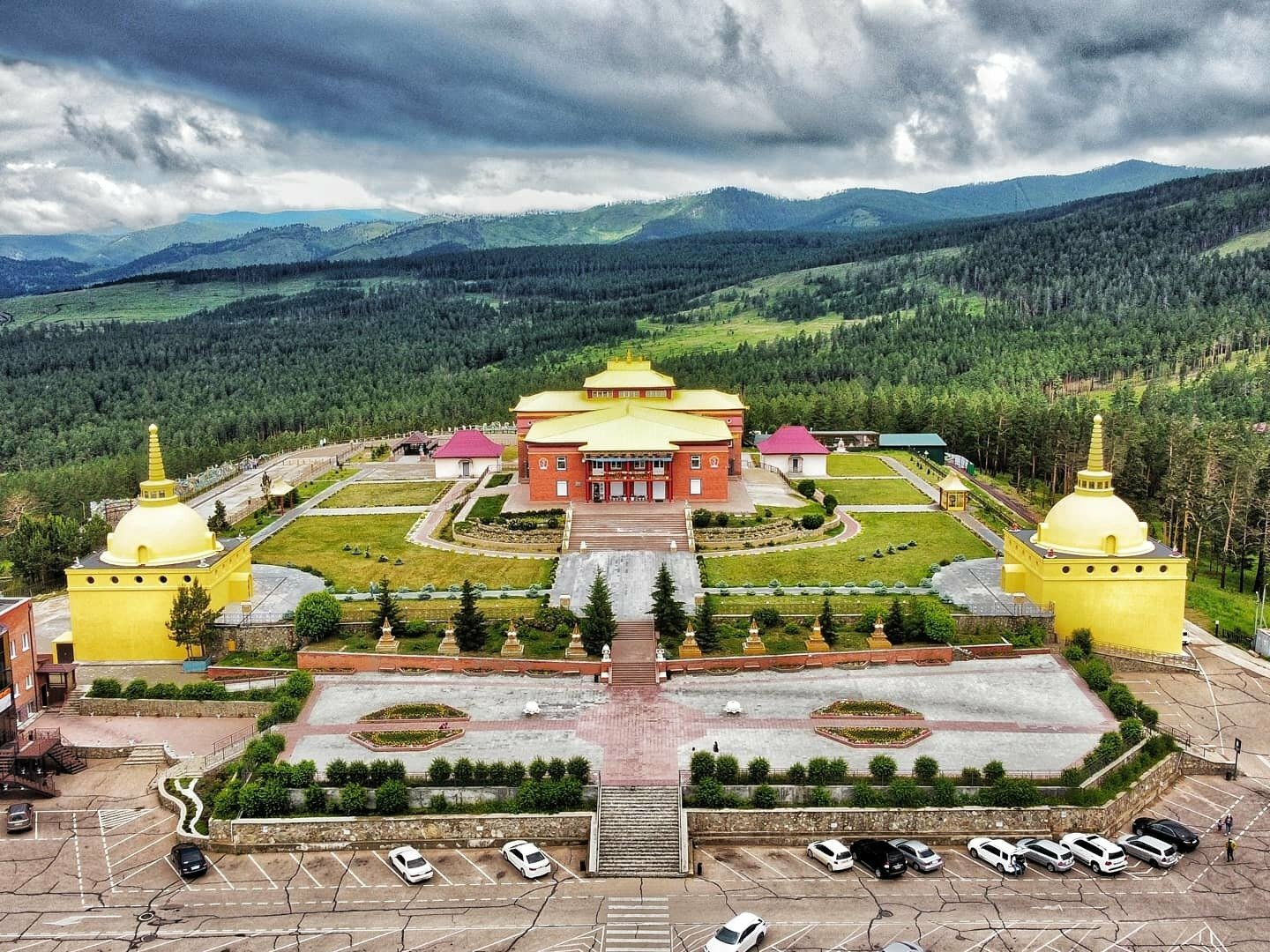
2 Rinpoche Bagsha Datsan
The datsan was built on Lysaya Mountain in 2004 and became a place of pilgrimage for believers from all over Russia, along with its “older brother” — the Ivolginsky Datsan. The temple complex is named after its founder, Yeshe Loda Rinpoche. Translated from Tibetan, "Rinpoche" means "precious", and "Bagsha" in Buryat means "Teacher". The datsan houses the largest statue of the Golden Buddha in Russia. The viewing deck offers stunning views of Ulan-Ude and the Selenga River, while you can see a monument to buuz in front of the temple— a national Buryat dish of meat wrapped in dough and steamed. A walking trail runs around the complex — the road of long life, decorated with figures of the twelve animals of the Chinese zodiac calendar and teachings of Buddhism. The statue was delivered to the datsan on February 17, 2004, on the eve of the White Moon, or "Sagaalgan" in Buryat.
The datsan was built on Lysaya Mountain in 2004 and became a place of pilgrimage for believers from all over Russia, along with its “older brother” — the Ivolginsky Datsan. The temple complex is named after its founder, Yeshe Loda Rinpoche. Translated from Tibetan, "Rinpoche" means "precious", and "Bagsha" in Buryat means "Teacher". The datsan houses the largest statue of the Golden Buddha in Russia. The viewing deck offers stunning views of Ulan-Ude and the Selenga River, while you can see a monument to buuz in front of the temple— a national Buryat dish of meat wrapped in dough and steamed. A walking trail runs around the complex — the road of long life, decorated with figures of the twelve animals of the Chinese zodiac calendar and teachings of Buddhism. The statue was delivered to the datsan on February 17, 2004, on the eve of the White Moon, or "Sagaalgan" in Buryat.
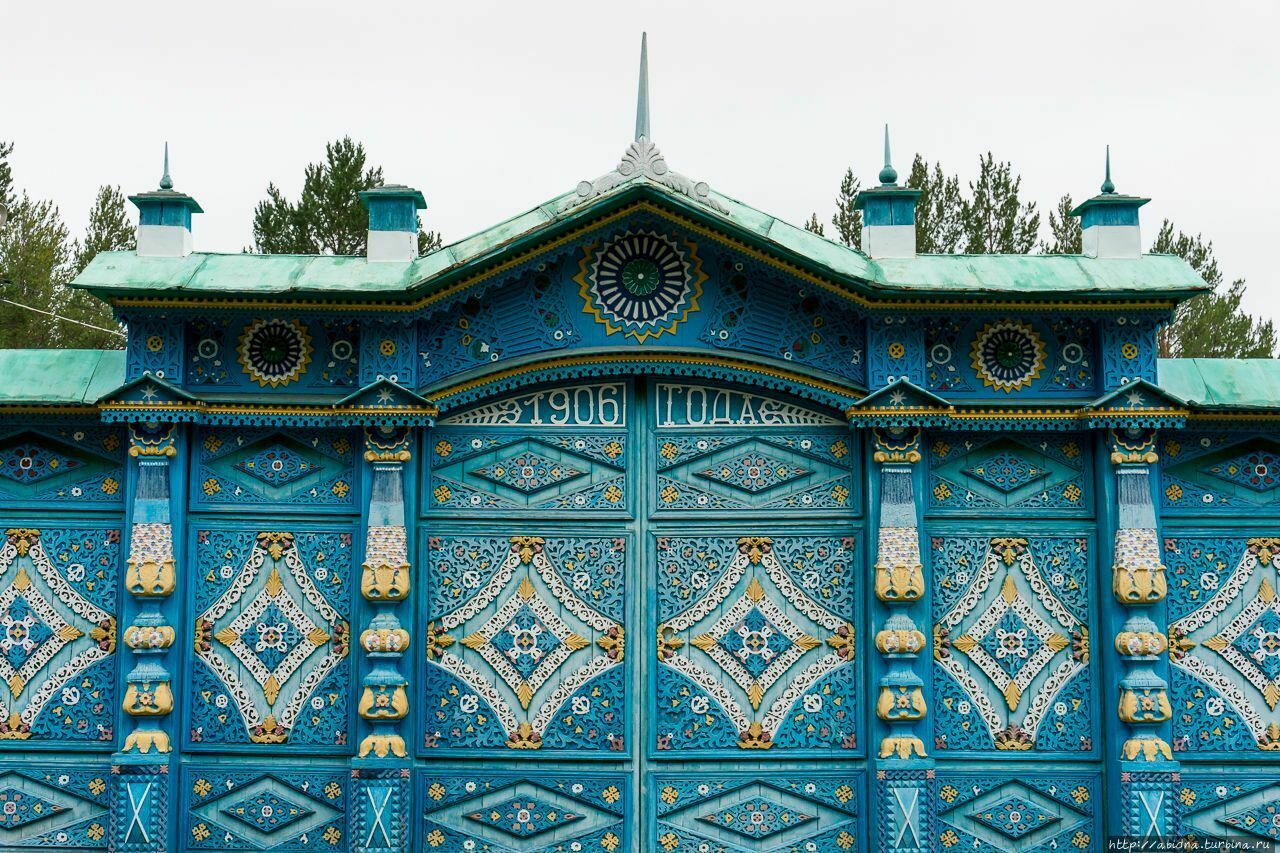
3 The Ethnographic Museum of the Peoples of Transbaikal
The museum is considered one of the largest open-air museums in Russia. Here you can see homes of the Transbaikal peoples and imagine how the Evenks, Soyots, the Baikalia and Transbaikal Buryats, Russian old-timers, the Cossacks and the Old Believers lived. Among the first exhibits were the St. Nicholas Church from the Mukhorshibirsky District and the Devazhin-dugan from the Tamchinsky datsan in the Selenginsky District of Buryatia, which were transported here in 1968.
Here you can also closely examine the Xiongnu dwelling, take a peek into the house of a 19th-century town doctor, visit the zoological garden and walk up and down the museum's winding paths.
The museum is considered one of the largest open-air museums in Russia. Here you can see homes of the Transbaikal peoples and imagine how the Evenks, Soyots, the Baikalia and Transbaikal Buryats, Russian old-timers, the Cossacks and the Old Believers lived. Among the first exhibits were the St. Nicholas Church from the Mukhorshibirsky District and the Devazhin-dugan from the Tamchinsky datsan in the Selenginsky District of Buryatia, which were transported here in 1968.
Here you can also closely examine the Xiongnu dwelling, take a peek into the house of a 19th-century town doctor, visit the zoological garden and walk up and down the museum's winding paths.
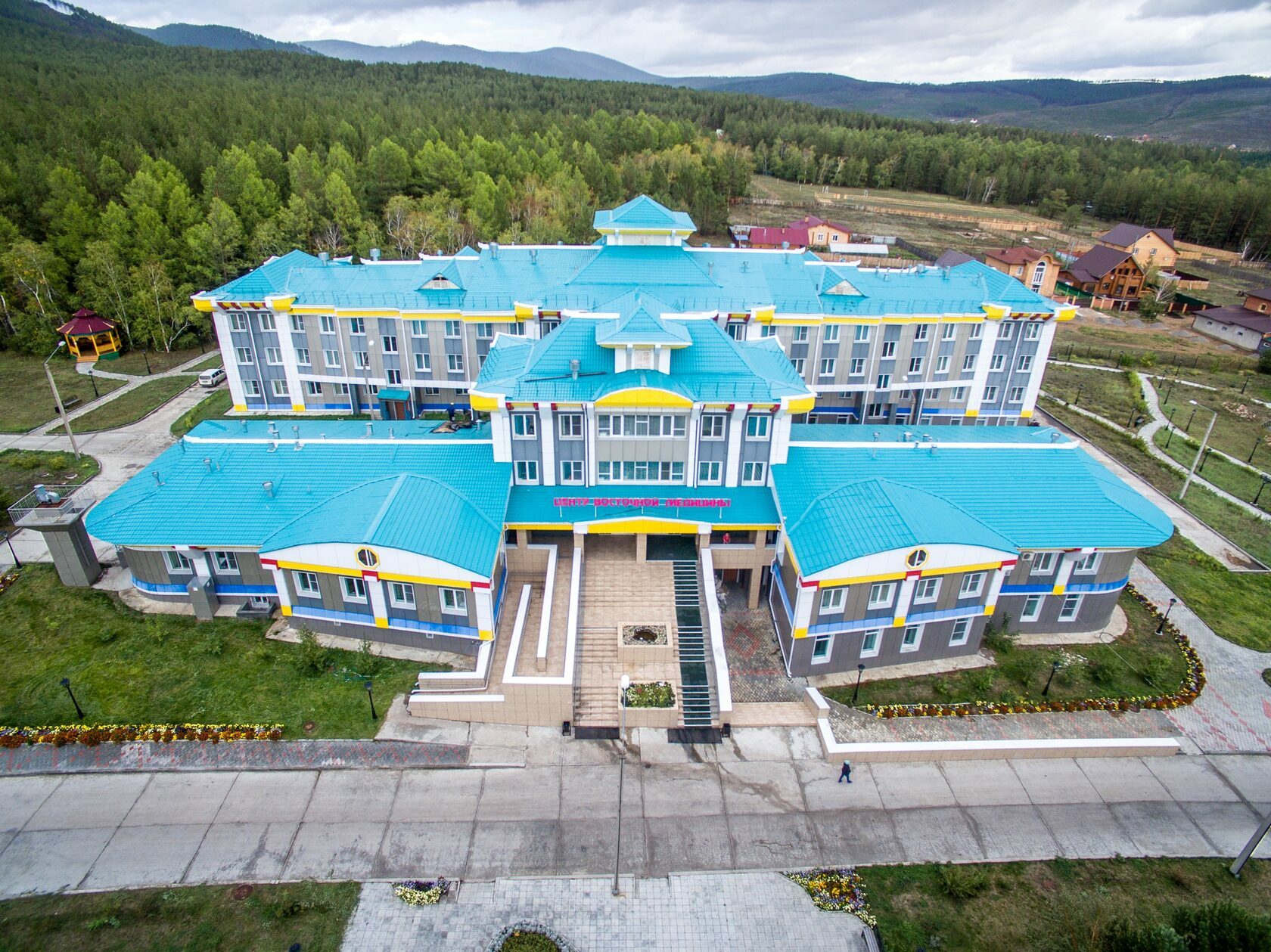
4 Traditional Asian Medicine Center
The Traditional Asian Medicine Center in Ulan-Ude is the only state medical institution that provides medical services that mix modern and traditional medicine. You won't find anything similar anywhere else in Russia. Drawing upon the thousand-year-old experience of Tibetan healers, doctors here practice acupuncture, massages, herbal medicine, wushu and qigong.
The Traditional Asian Medicine Center in Ulan-Ude is the only state medical institution that provides medical services that mix modern and traditional medicine. You won't find anything similar anywhere else in Russia. Drawing upon the thousand-year-old experience of Tibetan healers, doctors here practice acupuncture, massages, herbal medicine, wushu and qigong.

5 M.H. Khangalov Museum of History of Buryatia
This is the main museum of Buryatia, where you can learn everything about the republic's history and art. Among the museum's unique exhibits are the collection of the cham dance costumes and masks, the manuscript of the Gesar epic as told by Buryat storyteller Papa Tushemilov, and the Ostrog Bible published by the printer Ivan Fyodorov in 1580. A separate exhibit is dedicated to the "Atlas of Tibetan Medicine", an exact copy of the monument of culture, art and science of 17th-century Central Asian and Tibetan peoples.
Atlas of Tibetan Medicine. Page 1. The "Fundamental Tantra" depicts Medicine Buddha Bhaiṣajyaguru (Tibetan: Manla) in Tanadug, the city of medicine, surrounded by four groups of healers: non-Buddhists, gods, rishi and Buddhists.
This is the main museum of Buryatia, where you can learn everything about the republic's history and art. Among the museum's unique exhibits are the collection of the cham dance costumes and masks, the manuscript of the Gesar epic as told by Buryat storyteller Papa Tushemilov, and the Ostrog Bible published by the printer Ivan Fyodorov in 1580. A separate exhibit is dedicated to the "Atlas of Tibetan Medicine", an exact copy of the monument of culture, art and science of 17th-century Central Asian and Tibetan peoples.
Atlas of Tibetan Medicine. Page 1. The "Fundamental Tantra" depicts Medicine Buddha Bhaiṣajyaguru (Tibetan: Manla) in Tanadug, the city of medicine, surrounded by four groups of healers: non-Buddhists, gods, rishi and Buddhists.
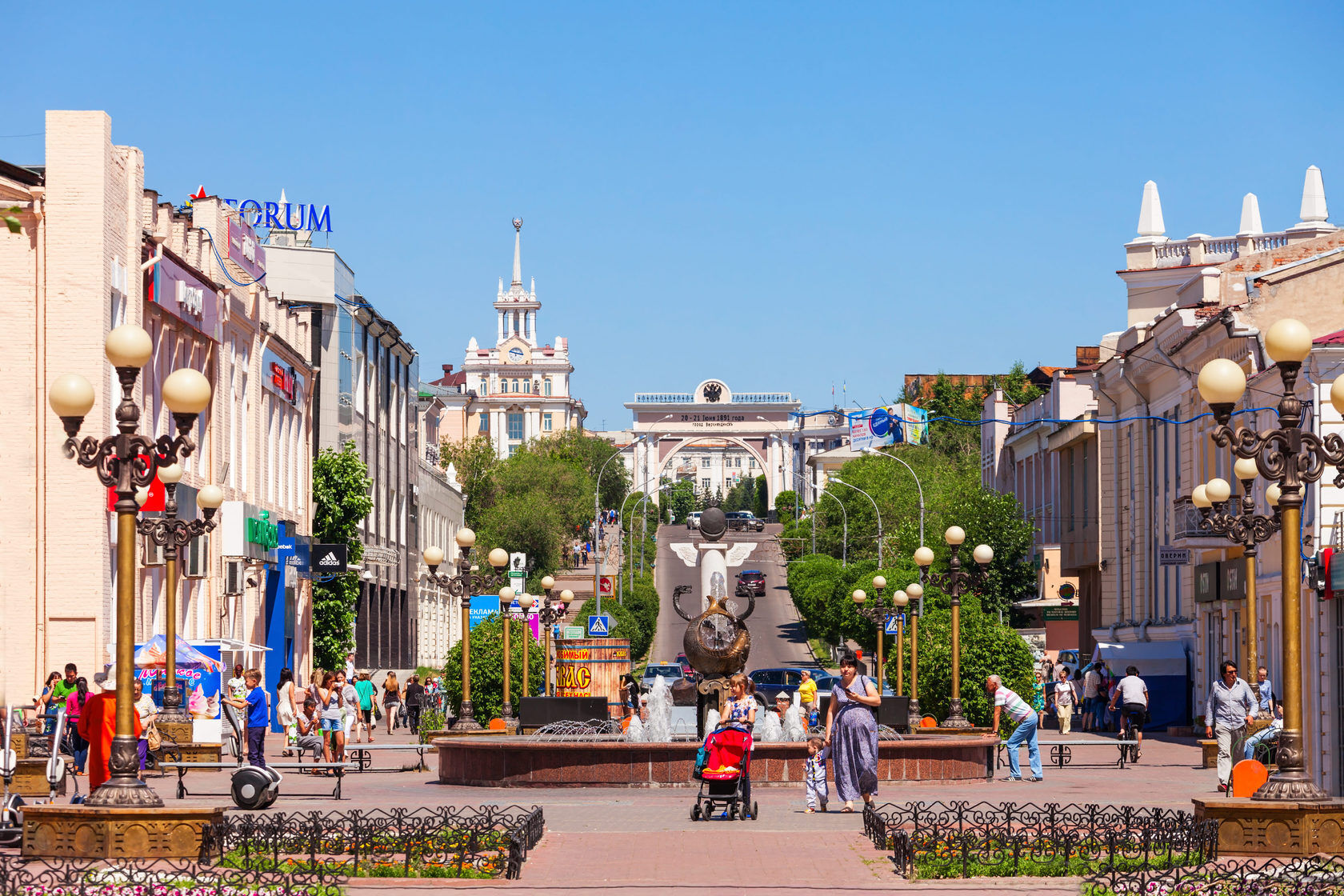
6 Arbat.
The pedestrian part of Lenina Street in Ulan-Ude is called the Arbat. Almost every building on this street has its own rich history. Take, for example, the two-story Kapelman house with the atlants, which was the place of the city's first candy shop and coffee shop, or the merchant Borisova house, which house the first Illuzion movie theater, and the Museum of City History building became the place where the future emperor of Russia Nicholas II stayed for one night in early 20th century. There are lots of various sculptures on the Arbat. One of such sculptures is the "Cornucopia", the very same that is present on the coat of arms of Ulan-Ude. There's also a monument to Anton Chekhov, a classical Russian writer. The writer was given such honor for his positive words about the city. After stopping by in Verkhneudinsk during his journey, Chekhov called the city "cute".
The pedestrian part of Lenina Street in Ulan-Ude is called the Arbat. Almost every building on this street has its own rich history. Take, for example, the two-story Kapelman house with the atlants, which was the place of the city's first candy shop and coffee shop, or the merchant Borisova house, which house the first Illuzion movie theater, and the Museum of City History building became the place where the future emperor of Russia Nicholas II stayed for one night in early 20th century. There are lots of various sculptures on the Arbat. One of such sculptures is the "Cornucopia", the very same that is present on the coat of arms of Ulan-Ude. There's also a monument to Anton Chekhov, a classical Russian writer. The writer was given such honor for his positive words about the city. After stopping by in Verkhneudinsk during his journey, Chekhov called the city "cute".

7 Museum of History of Ulan-Ude
The Museum of History of Ulan-Ude is situated at the very center of Lenina Street. It's located in the main part of the mansion that belonged to Ivan Goldobin, a merchant, owner of gold mines and a philanthropist. Numerous halls of the museum will tell you how Verkhneudinsk (the original name of the city) came to be, who founded it, and how the Ulan-Ude people lived before the revolution and in Soviet times. You can learn a lot about the townsfolk's daily life, work and pastime by studying photographs and household items.
In the museum, you will be under the watchful eye of Samuel the museum cat, the famous cranky museum attendant, who has been living here for over 13 years.
The Museum of History of Ulan-Ude is situated at the very center of Lenina Street. It's located in the main part of the mansion that belonged to Ivan Goldobin, a merchant, owner of gold mines and a philanthropist. Numerous halls of the museum will tell you how Verkhneudinsk (the original name of the city) came to be, who founded it, and how the Ulan-Ude people lived before the revolution and in Soviet times. You can learn a lot about the townsfolk's daily life, work and pastime by studying photographs and household items.
In the museum, you will be under the watchful eye of Samuel the museum cat, the famous cranky museum attendant, who has been living here for over 13 years.
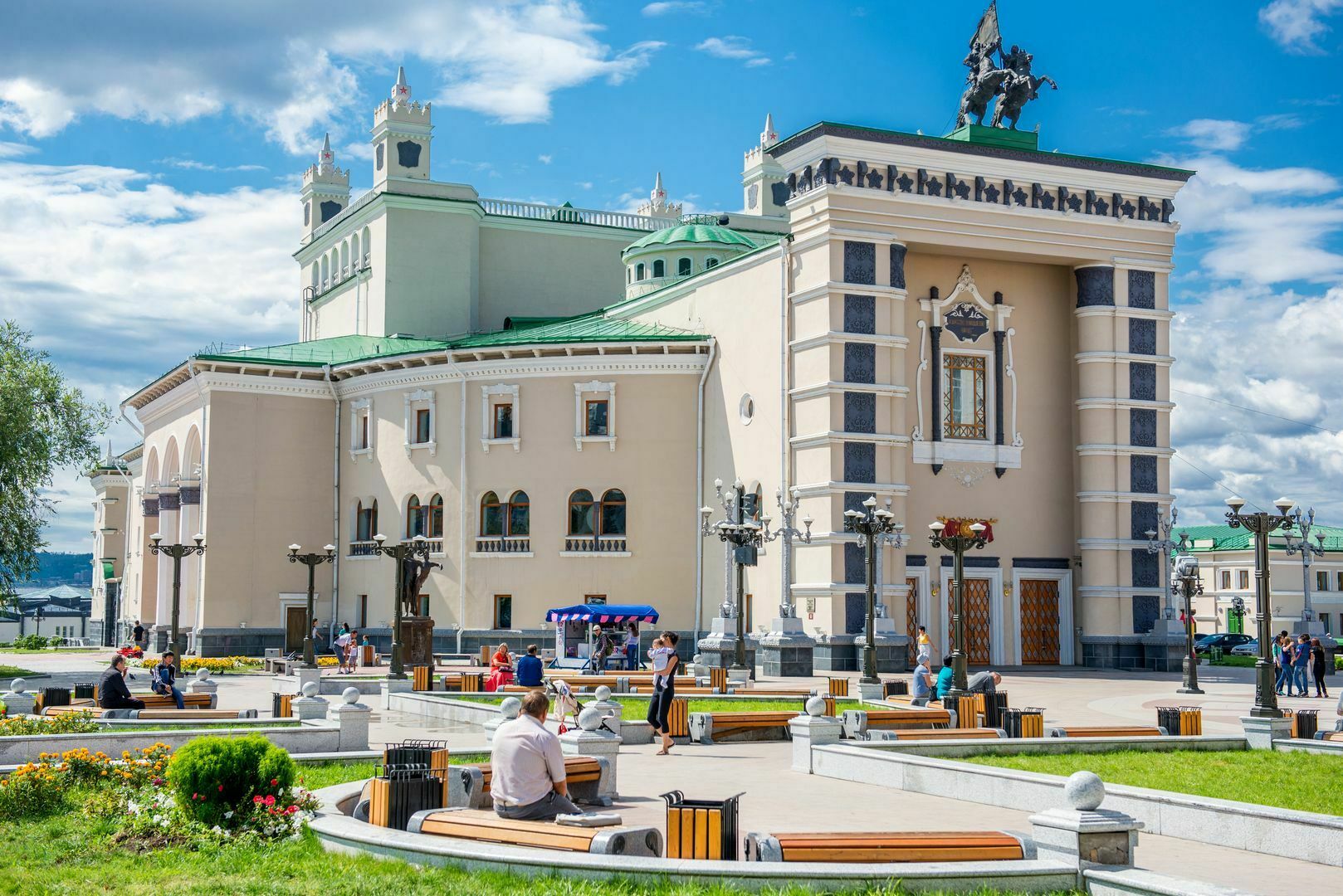
8 Teatralnaya Square and the G.Ts. Tsyndynzhapov Buryat Theater of Opera and Ballet
On summer evenings, locals and tourists love to gather up at the singing fountain on Teatralnaya Square. Streams of water combine in peculiar ways with classical music, including the music composed by Buryat musicians. The square is surrounded by the Radio House, a new facility of the Buryat State University and, of course, the magnificent building of the Buryat Theater of Opera and Ballet. The theater's facade is decorated with reliefs, on which you can see sables and squirrels, and inside you'll se the monumental Friendship of Peoples high relief and other attributes of the Stalinist style. The theater performs classical plays and plays written by modern playwrights or based on the Buryat epic poetry. The Beautiful Angara Monument commemorates Larisa Sakhyanova and Pyotr Abasheyev, the legends of the Buryat Theater. It was erected in 2000.
On summer evenings, locals and tourists love to gather up at the singing fountain on Teatralnaya Square. Streams of water combine in peculiar ways with classical music, including the music composed by Buryat musicians. The square is surrounded by the Radio House, a new facility of the Buryat State University and, of course, the magnificent building of the Buryat Theater of Opera and Ballet. The theater's facade is decorated with reliefs, on which you can see sables and squirrels, and inside you'll se the monumental Friendship of Peoples high relief and other attributes of the Stalinist style. The theater performs classical plays and plays written by modern playwrights or based on the Buryat epic poetry. The Beautiful Angara Monument commemorates Larisa Sakhyanova and Pyotr Abasheyev, the legends of the Buryat Theater. It was erected in 2000.
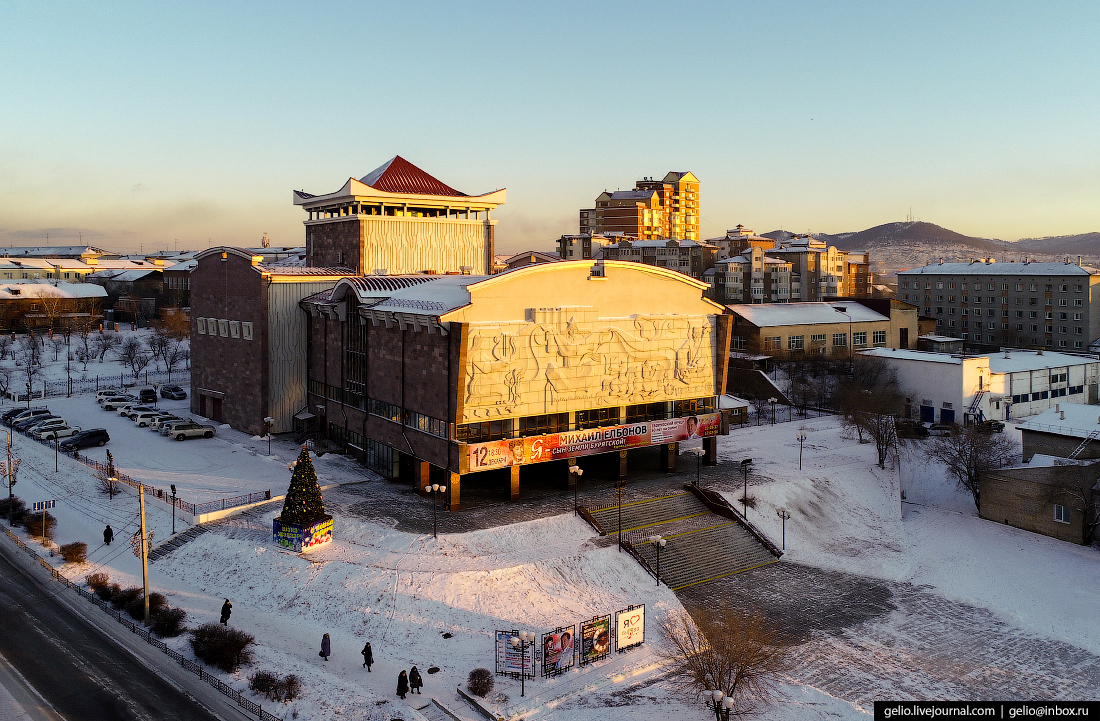
9 The Hots Namsarayev Buryat Academical Drama Theater
"Burdam", or Buryaad theater, as it's commonly called, is the only theater in the world where performances, even those based on the Russian or foreign classics, are staged in Buryat. The building decorated with volcanic tuff proudly towers above the city. The theater façade has a “Blooming Buryatia” bas-relief, and elements of traditional crafts are used inside: a panel by the Buryat artist Alla Tsybikova, a horsehair curtain, chandeliers stylized as silver jewelry, and Florentine mosaics only consisting of stones collected in Buryatia.
"Burdam", or Buryaad theater, as it's commonly called, is the only theater in the world where performances, even those based on the Russian or foreign classics, are staged in Buryat. The building decorated with volcanic tuff proudly towers above the city. The theater façade has a “Blooming Buryatia” bas-relief, and elements of traditional crafts are used inside: a panel by the Buryat artist Alla Tsybikova, a horsehair curtain, chandeliers stylized as silver jewelry, and Florentine mosaics only consisting of stones collected in Buryatia.
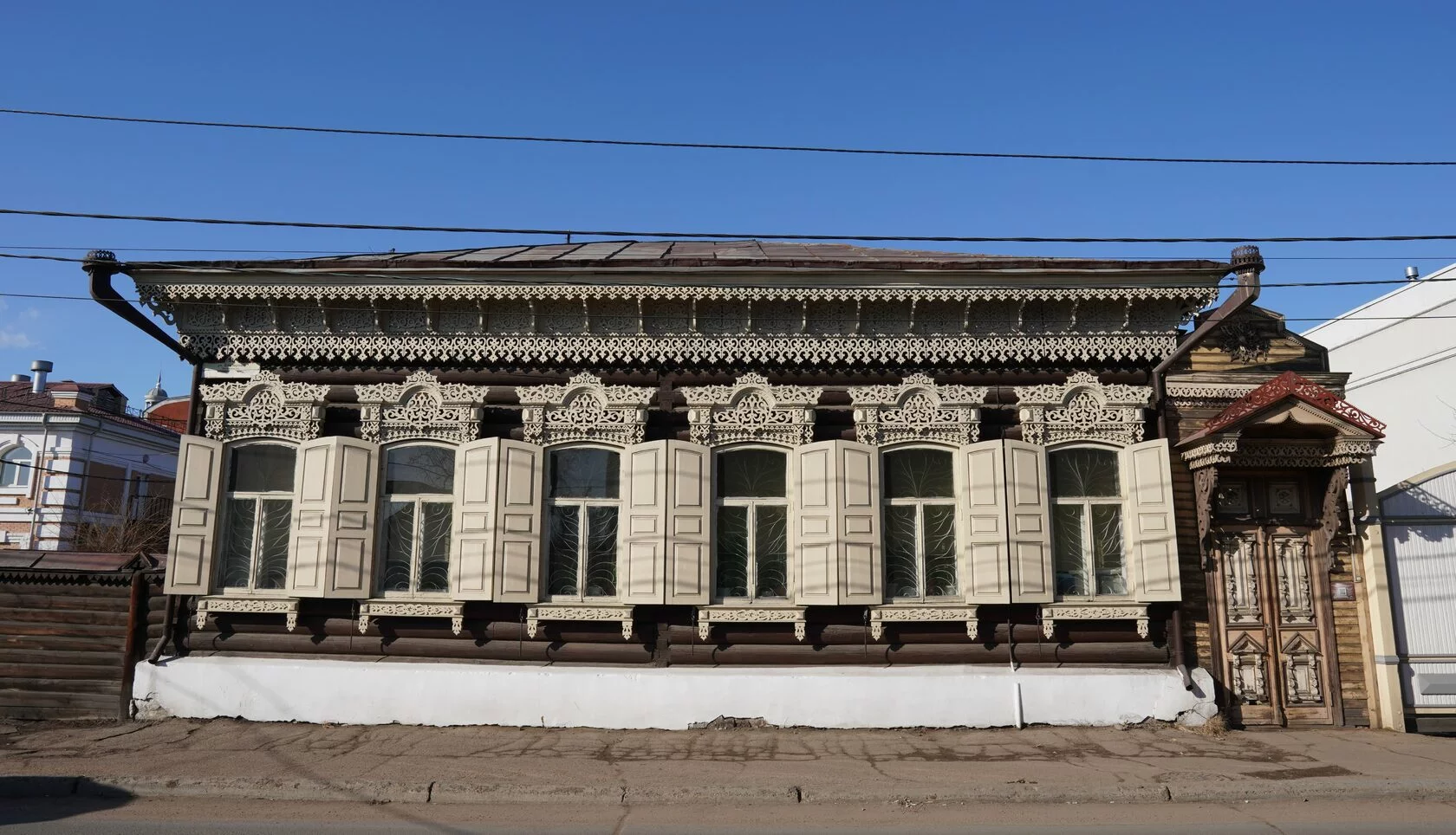
10 Old City
The central part of Ulan-Ude with preserved historical buildings is commonly called the Old City. Many buildings here are filled with the spirit of the times and look the same as the day the were built. Pay attention to every little detail while exploring the district. Every element on the carved platbands and edges had a special meaning. Most often you'll see figures reminiscent of the sun, horses, flowers and wheat heads. At the heart of the Old City lies Sobornaya Street lined with restored houses of Verkhneudinsk residents. Some of them are still residential, some have cafés and shops. For example, the Skrylnykova Eating House is located in the house that belonged to the merchant of the same name, and in a nearby two-story building you'll find the clinic of the Traditional Asian Medicine Center. The Lev Bardamov Museum-Gallery is also located not far from Sobornaya Street. It's a private museum that started with a small collection of a local artist and now comprises over five thousand items, including ancient maps, household items of Verkhneudinsk residents, rare books and works of famous Buryatian artists.
The central part of Ulan-Ude with preserved historical buildings is commonly called the Old City. Many buildings here are filled with the spirit of the times and look the same as the day the were built. Pay attention to every little detail while exploring the district. Every element on the carved platbands and edges had a special meaning. Most often you'll see figures reminiscent of the sun, horses, flowers and wheat heads. At the heart of the Old City lies Sobornaya Street lined with restored houses of Verkhneudinsk residents. Some of them are still residential, some have cafés and shops. For example, the Skrylnykova Eating House is located in the house that belonged to the merchant of the same name, and in a nearby two-story building you'll find the clinic of the Traditional Asian Medicine Center. The Lev Bardamov Museum-Gallery is also located not far from Sobornaya Street. It's a private museum that started with a small collection of a local artist and now comprises over five thousand items, including ancient maps, household items of Verkhneudinsk residents, rare books and works of famous Buryatian artists.